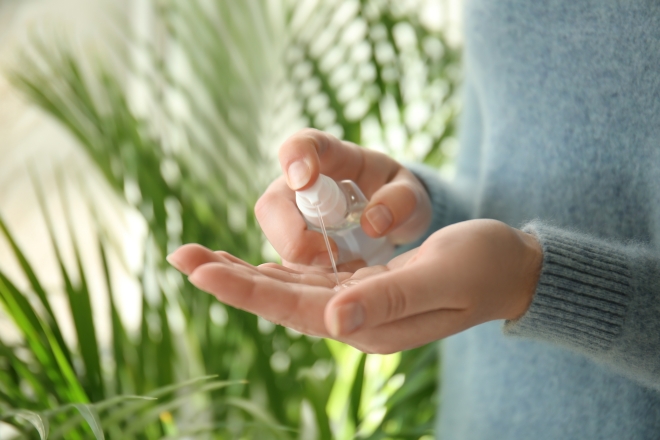There is some truth in the saying “keep calm and wash your hands.” A traditional bar of soap is so good at removing substances from your hands that it not only washes away dirt but other undesirables as well. Mixed with good hand washing techniques (at least 3 minutes if you have something gnarly on your hands), soap is able to remove bacteria, fungi, protists (such as single-celled amoeba) effectively.
Yet, if you are road tripping, at a music festival or at school without soap, hand sanitiser can be extremely handy. Alcohol-based hand sanitisers can quickly reduce the number of microbes on hands in some situations, but take heed, sanitisers do not eliminate all types of germs.

The best way to use hand sanitiser is to wash your hands with soap first, then apply a thin coating of hand sanitiser.
The recipe
This hand sanitiser uses rubbing alcohol and ‘Thieves’ essential oil blend. Rubbing alcohol (also called surgical spirit and ethanol based liquid) is a solution made of isopropyl alcohol and water. It is commonly used as an antiseptic and in cleaning solutions. For this recipe you will need:
- 1 cup of rubbing alcohol
- 1/2 cup of 99% aloe vera gel
- 50 drops of Thieves essential oil blend
- A squirt bottle or two
Part One: Making the Thieves essential oil blend
Thieves essential oil blend is believed to be a strong disinfectant. So strong that it was supposed to ward off the Black Plague in the 14th century. Curiously this blend was created by thieves.
The four thieves protected themselves from the Black Plague with cloves, rosemary, lemon and cinnamon while robbing victims of the killer disease.
When the King heard about the story of the thieves he wanted to know their secret. The thieves were caught and brought before the King. He gave them a choice to either share their secret of “immunity” or be burned at the stake. They decided to share their secret. The King immediately posted the thieves secret formula all over the town. So here it is!
In a 15 ml bottle amber or cobalt bottle add essential oils:
40 drops of clove oil which is an analgesic, antibacterial, antifungal, anti-inflammatory, a strong antiseptic and an immune stimulant.
35 drops of lemon oil which contains a powerful antioxidant called d-limonene that has been linked to healthy immune system function.
20 drops of cinnamon oil which is antibacterial, antifungal, anti-inflammatory, antimicrobial, antiviral and antiparasitic.
10 drops of rosemary oil which is an analgesic, antibacterial, antifungal, anti-infectious, and also an expectorant.
My favourite tweak is the addition of 15 drops of eucalyptus essential oil which is analgesic, antibacterial, anti-infectious, antiviral, and expectorant.

Part Two: Making the Hand Sanitiser

- Gently mix rubbing alcohol and aloe vera gel in a bowl. If you would like to make your own aloe vera gel, check out the recipe here.
- Add Thieves essential oil blend.
- Pour into several squirt bottles.
- Label and date the squirt bottles.
- Store the bottle away from direct sunlight.
Use as needed to remove germs from hands.
And what of antibacterial soap?
A study done by the University of California found that just infusing regular soap with compounds like triclocarban or triclosan typically creates antibacterial soaps. The FDA has recently stated that there is little evidence that either triclosan or triclocarban infused soaps are more efficient at removing germs than soap by themselves. In response to the dubious benefits of antibacterial soaps, the Food and Drug Administration has actually instituted a ban on hand soaps which contain antibacterial ingredients, citing that there aren’t enough benefits to merit the inclusion of the substances.
So when it comes to washing your hands, plain old soap, with a little technique and water will do just fine.






